By: Gowans Feed Consulting Applied Nutrition Team
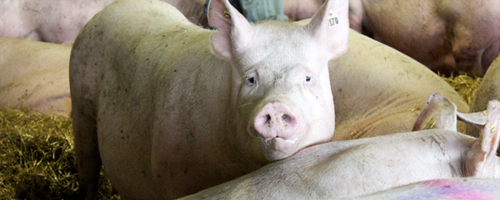
Pig production has changed substantially in the last few decades with the modern hyper prolific sow today having the capability of producing large litter sizes and weaning very high numbers of pigs per litter, thus requiring sound nutrition and feeding strategies to support these high levels of production. Nutrition and management of gilts during the development period and early stages of life to the end of first parity, has a significant impact on lifetime performance of these females, thus is an important stage to setup these females for lifetime success. There is sound nutritional information available from numerous applied research trials and commercial experience with feeding the modern sow. Therefore, it is important to use up to date information when formulating diets and developing feeding programs for the modern hyper prolific animal. Current feeding programs must be designed for optimum biological performance in a cost effective manner, and not to maximize biological performance at any cost. This paper will review some of the key applied areas of nutrition and feeding strategies for the modern prolific sow.
Gilt Development and Feeding
The nutritional program for replacement gilts has a direct effect on sow lifetime productivity. Our objective on the feeding program for replacement gilts is to increase body reserves of key nutrients during the developing period while optimizing mature body size in order to achieve maximal reproductive productivity and longevity. Many factors including genotype, housing environment, lighting regime, movement, nutrition, feed intake, and exposure to a mature boar can affect the age a gilt reaches puberty (1, 2). Research has demonstrated that number of ovulations increases during the first 3 estrus cycles after reaching puberty, then remains relatively constant (3). Therefore, gilts should be mated preferentially on their second or third cycle to maximize litter size and future reproductive performance while minimizing additional non-productive days that accumulate with later mating. Nutritional recommendations for maternal line gilts should allow for:
1. Birth to first breeding growth rate of 650 to 725 g/day growth rate.
2. Achieve a live body weight of 135 kg at first services around 200 to 210 days of age.
Suggested diet nutrient recommendations for some key nutrients are detailed in Table 1. Ideally, replacement gilts should be fed differently from 25 kg and for sure no later than 75 kg body weight to build adequate body reserves that are needed for lifetime productivity. Ad libitum or full feeding means that replacement gilts are self-fed and no limit is placed on feed intake. Feeder design and space allowance should not influence feed intake. Feeder design characteristics should have a minimum 38 cm shoulder width, 25 cm deep and ideally a divider to provide some degree of pig protection. The latter forces the pigs to stand perpendicular to feeder to eat and decreases rooting and pig to pig interaction. Ideally we want to have no more than 10 gilts per feeder space. Target is to have 10 gilts per nipple drinker, set 60-76 cm high, and flow rate of 1.5 Litre/minute.
Any feed restriction or disruption during the last 3 weeks before breeding can be detrimental to ovulation rate and first litter size. It is important to move replacement gilts to individual stalls ideally 3 weeks and a minimum of 2 weeks prior to first service to overcome the effect of feed disruption produced by the move. All vaccinations and booster shots should be completed prior to stalling and 3 weeks before breeding.
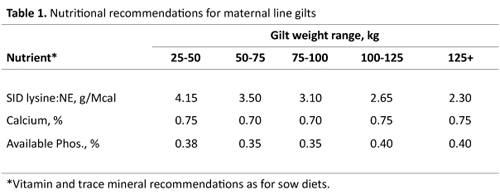
Feeding during Gestation
Nutrient requirements for gestating sows can be broken down into 3 basic components: maintenance, fetal growth and maternal weight gain. Requirements for maintenance are primarily influenced by the body weight of the sow and the environment in which the female is housed. Older, heavier sows have increased nutrient needs and will require more feed to maintain their body than younger, lighter sows. Maintenance energy requirements account for 75-85% of the sows total energy requirement. Determining the proper feeding level is very important to the success of a gestation feeding program. The correct feed allowance will ensure large heavy litters and allow body tissue reserves for the upcoming lactation. Target weigh gain during gestation guidelines should be 50 to 55 kg in their first gestation for gilts bred at 130-145 kg initial BW, 45 to 50 kg for first parity sows, 35 to 40 kg for parity 2 to 5, and 30 kg for parity 6 and older sows.
Determining the correct feeding level can be achieved in a number of different ways including: i) A visual estimate of condition, ii) Using an estimate of sow weight and backfat thickness to determine feeding level. Feeding based on body condition scores is whereby base feeding level is determined and is adjusted up or down according to sow body condition score (Figure 1; 4). Sows are scored on a scale of 1 (thin) to 5 (fat), and are fed to achieve a condition score of 3 at farrowing. Sows should be conditioned scored periodically through gestation to determine if the feeding levels need to be adjusted to achieve condition score of 3 at farrowing. Though this system is easy to implement, it is not very accurate. Sows with the same condition score can have very different backfat levels. Reasons for the variation are likely due to differences among personnel doing condition scoring and differences in the degree of muscling present in sows. If setting feeding level during gestation based on BCS it is important to use some estimate of weight and assessment of backfat and muscle depth, as weight has the largest impact on sow maintenance (75-80% of requirements) and fat and muscle serve as reserves during lactation.
Figure 1. Condition scoring system for sows.
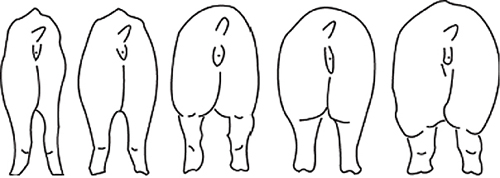
Body Condition (BC) Scores are arranged from 1 (left) which is assigned to emaciated sows to 5 (right) which is very fat sows. A score of 3 is ideal.
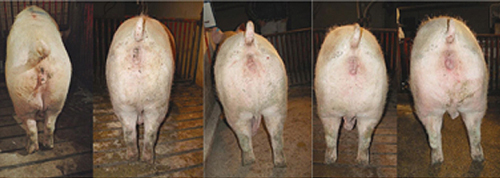
Picture reference: Dr. Ken Stalder and National Hog Farmer magazine.
A more accurate method to set feeding levels for gestation is to take an estimate of sow weight at breeding using flank to flank tape (Figure 2) and/or measuring backfat thickness (Table 2). While backfat probes have different degrees of accuracy and must have a trained operator, they are more accurate than visual condition score.
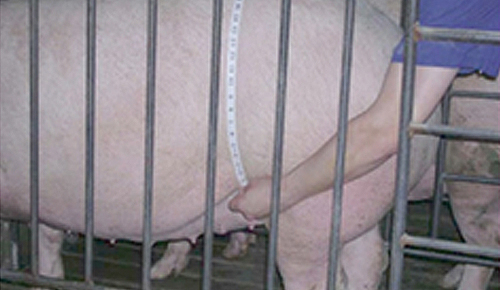
Figure 2. Flank to flank measurement of sow to estimate body weight

Feeding table matrix based on sow weight and backfat categories (at breeding) have been developed (Table 3). The latter method will reduce the number of over conditioned sows and reduce overall gestation feed costs due to more precise feed allowance when compared with feeding based on body condition score. Both thin and fat sows carry undesired consequences, with fat sows being a much more complex issue. Some of these consequences are: i) higher cost of production; ii) impaired mammary development; iii) higher stillborns and dystocia; iv) reduced feed intake in lactation; v) large body weight loss during lactation; vi) sows tend to have lower litter size in subsequent litter; vii) higher sow death loss.
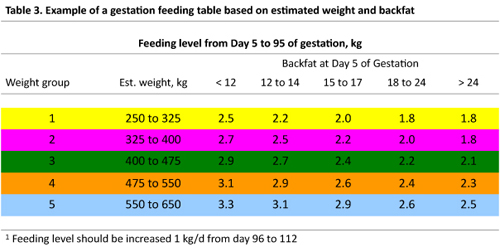
Method of feed delivery system should be checked for accuracy on a regular basis. This is very important for systems that use volumetric measures to set daily feed allowance. Changes in bulk density will change the amount of feed that the sow receives. The design of the feed drop and method of installation (angle of the hopper) can impact the amount of feed it delivers at different settings. The amount of feed delivered should be checked at least quarterly and ideally monthly to verify the amount of feed that is getting delivered versus what is expected.
Research from the University of Alberta (5) have shown that amino acid requirements during gestation change by parity and stage. Their data showed that both threonine to lysine ratio changes as gestation progresses and as sow ages (Table 4). They suggested that the magnitude of the change in requirements made it difficult to satisfy the requirements using a single diet during gestation.
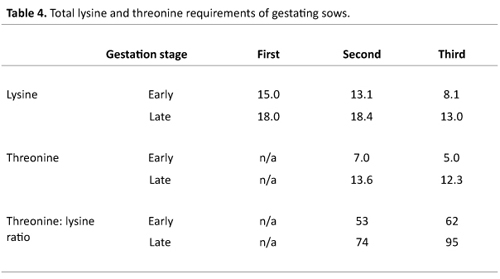
As genetic companies have selected for larger litters in the last 6-8 years we have observed piglet birth weight to decrease by 100 g. Recent research (6) looked at the impact of amino acid and energy intake in late gestation (day 90 to 111) on sow and litter performance (Table 5). Gilts gained more weight than sows, and weight gain in late gestation was impacted by both energy and amino acid intake. Sows fed increased energy levels had higher stillborn rate, but this was not observed in gilts. Piglet birth weight was increased by 30 g due to higher energy intake but increasing feeding level by 2 lb in late gestation increased feed cost per pig by $0.21. We need to be cautious when increasing feeding level in late gestation as it can increase stillborns and if sows get too fat they will have reduced feed intake during lactation, reduced milk production and weaning weights will be lower.
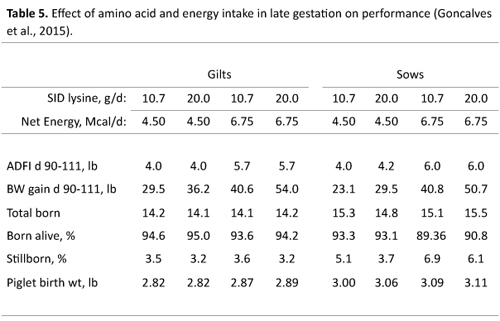
Lactation feeding
Lactation is the most demanding phase of the reproductive cycle, with significant energy being required for milk production. The lactating sow needs energy and nutrients to maintain body tissues and support milk production, while allowing for maternal growth, the latter especially for younger parity sows. It has been demonstrated in many studies that over feeding during gestation has a large negative impact on sow feed intake, milk production, weaning weights and subsequent reproduction (7). Sow longevity is also negatively impacted by excessive body weight gain and fatness (8), while excessive energy intake can compromise mammary development during gestation and may reduce milk production in the subsequent lactation (9).
In the last decade we have seen major changes in how we feed the lactating sows and these changes have largely impacted sow production of milk and litter weight gain. The move to full feeding after farrowing has allowed the modern prolific sow to produce more milk and reproduce subsequently at a level that she has been selected for by genetic companies. Some recent research from Europe (10) looked at the impact of full feeding peri-farrowing compared with restricted feeding. The sows fed ad libitum self-regulated and reduced feed intake coming up to farrowing and increased feed intake a lot faster after farrowing than the restricted fed sows (Figure 3). In their research, benefits have been also observed for sows fed ad lib compared with those restricted showing higher weight gains in the ad libitum system when sows have <18 and 18-22 mm backfat at the start of the peri-farrowing period (Figure 4). Therefore, for sows less than 22 mm of backfat at farrowing the ad libitum feeding from placement in the farrowing room increase feed intake prior to weaning, reduce the loss of body weight and backfat, and improve litter growth and weaning weight. Their data also demonstrates the need to avoid having sows over 22 mm of backfat at farrowing. By turning on the self-feeders when sows are loaded into farrowing during the first few days the sows will consume more feed. Benefits in colostrum composition in terms of immunoglobulin (Igg) content were also observed.
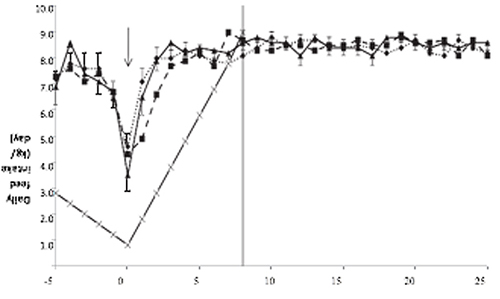
Figure 3. Voluntary feed intake (VFI) of sows fed ad libitum during the peripartal period (mean ± SEM). Based upon back fat thickness on d 105 of gestation sows were classified in one out of three body condition groups (C): LEAN (BF < 18 mm, · · + · ·), MODERATE (18 mm < BF < 22 mm, - - • -), or FAT (BF > 22 mm,— • —). The standard applied restricted feeding scheme is presented on the graph (— × —) in order to allow comparison with the VFI of ad libitum fed sows. The vertical arrow on the graph indicates the moment of farrowing, the vertical line on the graph separates the peripartal period from the rest of lactation (10).
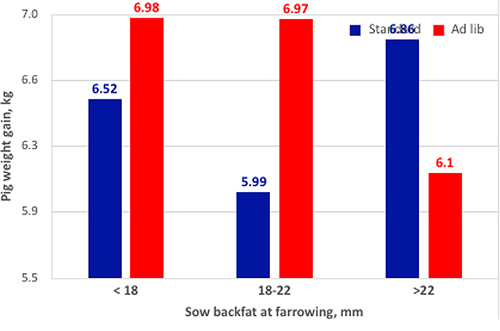
Figure 4. Influence of peripartum feeding of the sow on piglet weight gain (Cools et al., 2014; 10).
It is important to remember that feed intake of first and second parity sows will be lower than older parity sows by the order of 15 and 5%, respectively. Thus, we need to keep this in mind, and use strategies to help reduce demand on these animals especially in last week of lactation. Split weaning when performed correctly is one of these strategies that has been demonstrated to work effectively to avoid excessive body weight loss of these younger parity sows and not impacting time of return to heat. In the split weaning the heaviest pig in the litter is removed off from first parity sows 1 week before full weaning, but not earlier than day 12 of lactation, in order to help reduce demand on these animals and minimize body tissue losses. This strategy when implemented correctly has been shown to reduce weaning to re-breeding interval and reduce/avoid a dip in second litter size. Managing farrowing room temperature to maintain the correct room temperature for the sow in order to allow maximum feed intake and provide the correct micro environment for the piglets is very important. For each degree over 21oC the effect of higher room temperature on feed intake is reduced by 0.1 kg/day.
An important and practical note thought obvious that we should not take for granted is daily management of ad lib feeders and ensure sows are got up once per day once room is complete farrowing for the latter. Though the feeders are set to provide free access to feed it is very important that the feeder bowls/tubes supplying the feed into the hopper/bowl is visually inspected daily to ensure feed is flowing freely, and feed in the bottom of the bowl is fresh; stale feed should be removed. Feeding sows wet feed versus dry feed has been shown to increase feed consumption 10-15% (11). However, with wet feeding additional feeder management is required so that wet feed is kept fresh in the feeder and that spoiled feed is removed.
Weaning to service feeding
Feeding of sows between weaning and re-breeding has not received the care and attention it deserves. Field experience from many successful producers challenge the conventional thinking that weaned sows do not each much. Today’s hyper prolific sow need maximum feed intake from entry to farrowing to breeding to maximize subsequent litter size, minimize weight loss during lactation, to reduces weaning to breeding interval and reduce herd non-productive days. More producers are moving to feeding sows as individuals, own self feeder with nipple drinker, to allow true ad libitum feed intake from weaning to breeding, as opposed to dropping feed in an open trough with water in it. The goal is to get weaned sows to eat 4.5 kg/day for the first 5 days after weaning and a total of 23 to 25 kg of total feed. The impact of offering feed in a self-ad libitum feeder well managed and water separately was demonstrated on higher total feed intake, reduced weaning to service interval, higher percent bred by 7 days and higher subsequent litter size (12). The effect of feeding between weaning and re-breeding is greater with younger parity sows. When managed correctly weaned sows eat more than what we expect. Our standard should be to provide weaned sows with full feed, individual stalls and nipple drinkers.
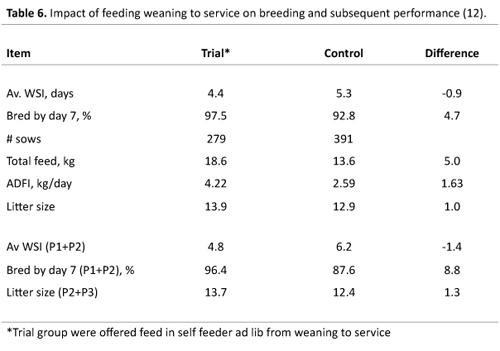
References
1. Patience, J. F. and P. A. Thacker. Nutrition of the Breeding Herd. In Swine Nutrition Guide. 1989. Pg 150-15.
2. Hughes, P. E. 1982. Factors affecting the natural attainment of puberty in the gilt. In: D. J. A. Cole and G. R. Foxcroft (Ed.), Control of pig reproduction. Butterworths, London, pp. 117-138.
3. den Hartog, L. A. and Van Kempen, G. J. M. 1980. Relation between nutrition and fertility in pigs. Neth. J. Agric. Sci. 28:211-227.
4. Moehn, S., D. Franco, C. Levesque, R. Samuel, and R. O. Ball. 2011. New Energy and Amino Acid Requirements for Gestating Sows. Advances in Pork Production volume 22. Pg 157-166.
5. Goncalves, M. A. D., K. M. Gourley, S. S. Dritz, M. D. Tokach, N. M. Bello, J. M. DeRouchey, J. C. Woodworth, and R. D. Goodband. 2015. Effects of Amino Acid and Energy Intake During Late Gestation on Piglet Birth Weight and Reproductive Performance of Gilts and Sows Housed Under Commercial Conditions. Kansas State University Swine Day 2015. Pg 1-15.
6. Sinclair, A. G., Bland, V. C., and Edwards, S.A. The influence of gestation feeding strategy on body composition of gilts at farrowing and response to dietary protein in a modified lactation. J. Anim. Sci. 2001. 79:2397-2405.
7. Dourmad J.Y., Etienne M., Prunier A., Noblet J. The effect of energy and protein intake of sows on their longevity: A review. Livest. Prod. Sci 1994; 40:87-97.
8. Weldon W. C., Thulin A. J., MacDougald O. A., Johnston L. J., Miller E. R., and Tucker H. A. Effects of increased dietary energy and protein during late gestation on mammary development in gilts. J. Anim. Sci. 1991; 69:194-200.
9. Cools A., Maes D., Decaluwé R., Buyse J., van Kempen T. A,. Liesegang A., and Janssens G. Ad libitum feeding during the peripartal period affects body condition, reproduction results and metabolism of sows. Animal Reproduction science 145: 130-140.
10. Genest, M. and S. D’Allaire. 1995. Feeding strategies during the lactation period for first parity sows. Can. J. Anim. Sci. 75:461-467.
11. Pinilla, J.C, Domingues, F., Mattews, N., Thompson, B., Teuber, R. E., Tubbs, J., and Mosqueira, P. Practical Feeding for high sow lifetime performance. PIC February 2015.


